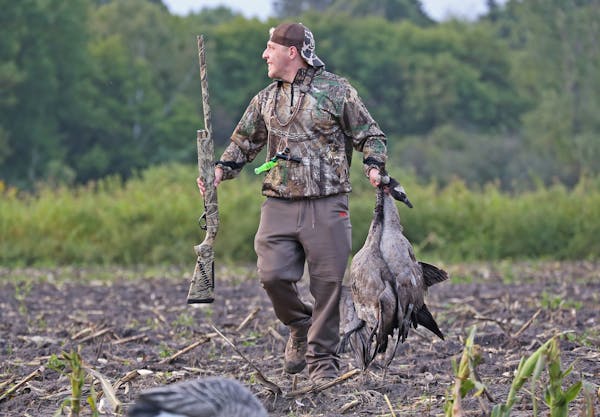Minnesota's hunting seasons will once again cascade throughout the fall and early winter starting this weekend with opportunities for geese, bears, mourning doves, crows, snipe and rail.
There's also an encroaching deadline Thursday for firearms and muzzleloader hunters who want to harvest antlerless deer in lottery permit areas. Hunters must purchase a license by Thursday to be entered into the chance drawings set for 39 of the state's 130 deer permit areas.
Deer hunters who want to participate in special firearm or muzzleloader hunts also need to apply for permits via lottery by the end of Thursday. All surplus bear permits for 2018 have already been sold.
This year's archery deer season opens Sept. 15. On the same date, grouse will become fair game along with squirrel and rabbit. One week later, Minnesota duck hunters will celebrate the opening of waterfowl season on Sept. 22.
The next major hunting season — for pheasants — opens Oct. 13 and will be celebrated in the southwestern Minnesota community of Luverne with two days of events tied to the Governor's Pheasant Hunting Opener.
Three weeks later in Hinckley, Gov. Mark Dayton and another hunting entourage will participate in the state's biggest hunting tradition: the firearm season for whitetails.
Deer herd management in 2018 once again includes precautions against the spread of chronic wasting disease (CWD). The prion disease has been detected on several state-licensed deer farms and in the wild population of deer in Fillmore County. The CWD-related regulations ban feeding in 11 central and north-central Minnesota counties broadly surrounding a pair of enclosed deer farms where captive deer were infected.
In southeastern Minnesota, the precautionary feeding bans are more intense. There, the Department of Natural Resources also has banned the use of attractants, including mineral blocks, urine, blood, bottled estrus and other enticements.
The ban on attractants relates to Houston, Olmsted, Mower, Wabasha and Winona counties and has been in place since last year. Wabasha County was added to the group this year because CWD was found in farmed deer in Winona County.
The bans on feeding and attractants are intended to reduce the number of areas where deer can come into close contact with each other and spread the disease.
Duck counts
Minnesota wetland conditions this year were similar to 2017, and various measurements by the U.S. Fish and Wildlife Service and DNR showed duck numbers at least on par with the recent past.
The state's total duck population, excluding scaup, was estimated during breeding season at nearly 700,000, 9 percent above the 2017 index and higher yet than the long-term average.
Mallards accounted for about 42 percent of the overall population, and this year's estimates were stable compared to 2017.
In the eastern Dakotas this year, total duck numbers were estimated in the same range as last year but were 33 percent above the long-term average.
